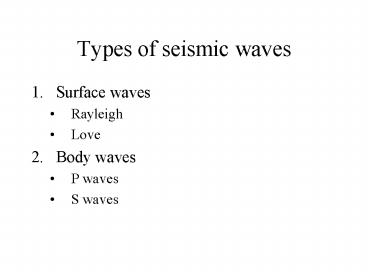Types of seismic waves - PowerPoint PPT Presentation
1 / 28
Title:
Types of seismic waves
Description:
P waves push and pull. Compressional waves. Travels through solid, liquid, and gas ... Usually not felt, but can be recorded by seismograph. 900,000. 2.5 to 5.4 ... – PowerPoint PPT presentation
Number of Views:826
Avg rating:3.0/5.0
Title: Types of seismic waves
1
Types of seismic waves
- Surface waves
- Rayleigh
- Love
- Body waves
- P waves
- S waves
2
Surface waves
- Rayleigh up and down motion
3
Surface waves
- Love waves side to side motion
- Causes damage to infrastructure
4
Body waves
- P waves push and pull
- Compressional waves
- Travels through solid, liquid, and gas
- Travel 1.7 times faster than the S wave
5
Body waves
- S waves
- Transverse waves
- Motion is perpendicular to wave propagation
- Travels only through solids
6
Body waves in a seismogram
7
P and S waves
- The difference in arrival times of P and S waves
can be used to determine the distance of the
earthquake.
8
P and S waves
- Triangulation is used to determine the exact
location of earthquake epicenters.
9
Magnitude vs Intensity
- Magnitude the total amount of energy released
during an earthquake - Proposed by Charles Richter in 1935
- Measured 100 km as the standard distance
- Wood-Anderson instrument
- Objective means of measuring earthquakes
10
Intensity
- Intensity - an indication of the destructive
effects of an earthquake at a particular place - Affected by factors such as
- Distance from epicenter
- Nature of underlying rock
- Quality of building materials
- Subjective means of measuring earthquakes
- Modified Rossi-Forrel scale
11
Magnitude scale
12
(No Transcript)
13
(No Transcript)
14
(No Transcript)
15
Effects of earthquakes
- During an earthquake, the region within 20-30 km
of the epicenter ordinarily experiences the same
degree of ground shaking. - Changes only with differences in underlying rock
type.
16
Hazards associated with earthquakes
- Fire
- Landslides
- Ground subsidence
- Liquefaction
- Ground rupture
- Collapse of structures
- Tsunami
17
Fire
- 1906 earthquake in San Francisco
- Most of the damage to S.F. was due to fire
18
Landslide
19
Ground subsidence
20
Liquefaction
21
Ground rupture
22
Collapse of structures
23
Tsunami
24
Prediction of earthquakes
- Long-term prediction
- made possible through determination of active
fault boundaries - Seismic gaps
25
(No Transcript)
26
Prediction of earthquakes
- Short-term prediction
- Abnormal emission of gases Radon (Ra230) from the
decay of Uranium (Ur238) - Swarms of tiny earthquake (foreshocks)
- Ground tilting uplift subsidence
- Measured by sensitive instruments (e.g. lasers,
radar interferometry)
27
Radar Interferometry
28
end































